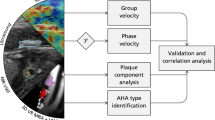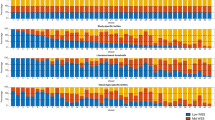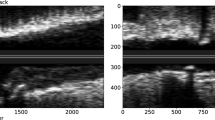Abstract
Acute coronary syndromes or sudden coronary death are often the first manifestations of coronary artery disease. In the majority of patients, acute coronary syndrome events are caused by plaque rupture in flow-limiting and non-flow-limiting angiographically intermediate stenoses. Histopathologic analyses have shown that plaque composition is related to the occurrence of acute clinical events and, therefore, to the vulnerability of the plaque. The emerging importance of adaptive coronary remodeling processes, such as the compensatory enlargement of the coronary artery in response to initial lesion development, has focused our interest on the nonstenotic lesions of the coronary tree. In vivo intravascular ultrasonography can demonstrate the discrepancies between the actual extent of coronary atherosclerosis and that seen by angiographic imaging. The spectral analysis of intravascular ultrasonography derived radiofrequency data enables more precise analysis of plaque composition and type than grayscale intravascular ultrasonography.
Key Points
-
Histopathologic analyses have shown that plaque composition is related to acute clinical events and, therefore, to the vulnerability of coronary plaques
-
The spectral analysis of intravascular ultrasonography-derived radiofrequency data enables more precise analysis of plaque composition and type
-
Intravascular ultrasonography derived virtual histology provides the most comprehensive imaging method for detailed assessment of plaque components in both cross-sectional and longitudinal views of the coronary artery
-
The present system for plaque classification by intravascular ultrasonography derived virtual histology represents the current translation of histopathological knowledge into in vivo intracoronary diagnosis
This is a preview of subscription content, access via your institution
Access options
Subscribe to this journal
Receive 12 print issues and online access
$209.00 per year
only $17.42 per issue
Buy this article
- Purchase on Springer Link
- Instant access to full article PDF
Prices may be subject to local taxes which are calculated during checkout







Similar content being viewed by others
References
Yusuf S et al. (2001) Global burden of cardiovascular diseases: Part II—variations in cardiovascular disease by specific ethnic groups and geographic regions and prevention strategies. Circulation 104: 2855–2864
Virmani R et al. (2006) Pathology of the vulnerable plaque. J Am Coll Cardiol 47 (8 Suppl): C13–C18
Libby P (2001) What have we learned about the biology of atherosclerosis? The role of inflammation. Am J Cardiol 88: 3J–6J
Libby P (2006) Inflammation and cardiovascular disease mechanisms. Am J Clin Nutr 83: S456–S460
Virmani R et al. (2000) Lessons from sudden coronary death: a comprehensive morphological classification scheme for atherosclerotic lesions. Arterioscler Thromb Vasc Biol 20: 1262–1275
Nissen SE and Yock P (2001) Intravascular ultrasound: novel pathophysiological insights and current clinical applications. Circulation 103: 604–616
Nissen SE (2002) Application of intravascular ultrasound to characterize coronary artery disease and assess the progression or regression of atherosclerosis. Am J Cardiol 89: 24B–31B
Nair A et al. (2006) Coronary plaque classification with intravascular radiofrequency data analysis. Circulation 106: 2200–2206
Falk E (2006) Pathogenesis of atherosclerosis. J Am Coll Cardiol 47 (8 Suppl): C7–C12
Libby P and Theroux P (2005) Pathophysiology of coronary artery disease. Circulation 111: 3481–3488
Potkin BN et al. (1990) Coronary artery imaging with intravascular high-frequency ultrasound. Circulation 81: 1575–1585
Tanaka A et al. (2005) Multiple plaque rupture and C-reactive protein in acute myocardial infarction. J Am Coll Cardiol 45: 1594–1599
Rioufol G et al. (2002) Multiple atherosclerotic plaque rupture in acute coronary syndrome: a three-vessel intravascular ultrasound study. Circulation 106: 804–808
Schoenhagen et al. (2003) Coronary plaque morphology and frequency of ulceration distant from culprit lesions in patients with unstable and stable presentation. Arterioscler Thromb Vasc Biol 23: 1895–1900
Yamagishi M et al. (2000) Morphology of vulnerable plaque: insights from follow-up of patients examined by intravascular ultrasound before an acute coronary syndrome. J Am Coll Cardiol 35: 106–111
Rioufol et al. (2004) Evolution of spontaneous atherosclerotic plaque rupture with medical therapy: long-term follow-up with intravascular ultrasound. Circulation 110: 2875–2880
Mathiesen EB et al. (2001) Echolucent plaques are associated with high risk of ischemic cerebrovascular events in carotid stenosis: the Tromsø study. Circulation 103: 2171–2175
Gronholdt ML et al. (2001) Ultrasonic echolucent carotid plaques predict future strokes. Circulation 104: 68–73
Burke AP et al. (2002) Morphological predictors of arterial remodeling in coronary atherosclerosis. Circulation 105: 297–303
Nair A et al. (2007) Automated coronary plaque characterisation with intravascular ultrasound backscatter: ex vivo validation. Eurointervention 3: 113–120
Nakashima Y et al. (2007) Early human atherosclerosis: accumulation of lipid and proteoglycans in intimal thickenings followed by macrophage infiltration. Arterioscler Thromb Vasc Biol 27: 1159–1165
Burke AP et al. (2001) Healed plaque ruptures and sudden coronary death: evidence that subclinical rupture has a role in plaque progression. Circulation 103: 934–940
Rodriguez-Granillo GA et al. (2006) Coronary artery remodelling is related to plaque composition. Heart 92: 388–391
Burke AP et al. (2001) Pathophysiology of calcium deposition in coronary arteries. Herz 26: 239–244
Falk E et al. (1995) Coronary plaque disruption. Circulation 92: 657–671
Kolodgie FD et al. (2003) Intraplaque hemorrhage and progression of coronary atheroma. N Engl J Med 349: 2316–2325
Nissen SE (2000) Rationale for a postintervention continuum of care: insights from intravascular ultrasound. Am J Cardiol 86: 12H–17H
Nissen SE et al.; CAMELOT Investigators (2004) Effect of anti-hypertensive agents on cardiovascular events in patients with coronary disease and normal blood pressure: the CAMELOT study: a randomized controlled trial. JAMA 292: 2217–2225
Schartl M et al. (2001) Use of intravascular ultrasound to compare effects of different strategies of lipid-lowering therapy on plaque volume and composition in patients with coronary artery disease. Circulation 104: 387–392
Nissen SE et al. (2004) Effect of intensive compared with moderate lipid-lowering therapy on progression of coronary atherosclerosis: a randomized controlled trial. JAMA 291: 1071–1080
Rodriguez-Granillo GA et al. (2006) Reproducibility of intravascular ultrasound radiofrequency data analysis: implications for the design of longitudinal studies. Int J Cardiovasc Imaging 22: 621–631
Diethrich EB et al. (2007) Virtual histology intravascular ultrasound assessment of carotid artery disease: the Carotid Artery Plaque Virtual Histology Evaluation (CAPITAL) study. J Endovasc Ther 14: 676–686
Rodriguez-Granillo GA et al. (2005) In vivo intravascular ultrasound-derived thin cap fibroatheroma detection using ultrasound radiofrequency data analysis. J Am Coll Cardiol 46: 2038–2042
Wang JC et al. (2004) Coronary artery spatial distribution of acute myocardial infarction occlusions. Circulation 110: 278–284
Valgimigli M et al. (2006) Distance from the ostium as an independent determinant of coronary plaque composition in vivo: an intravascular ultrasound study based radiofrequency data analysis in humans. Eur Heart J 27: 655–663
Glagov S et al. (1987) Compensatory enlargement of atherosclerotic coronary arteries. N Engl J Med 316: 1371–1375
Schoenhagen P et al. (2000) Extent and direction of arterial remodeling in stable vs. unstable coronary syndromes: an intravascular ultrasound study. Circulation 101: 598–603
de Boer OJ et al. (1999) Leucocyte recruitment in rupture prone regions of lipid rich plaques: a prominent role for neovascularization? Cardiovasc Res 41: 443–449
Kolodgie FD et al. (2003) Intraplaque hemorrhage and progression of coronary atheroma. N Engl J Med 349: 2316–2325
Carlier S et al. (2005) Vasa vasorum imaging: a new window to the clinical detection of vulnerable atherosclerotic plaques. Curr Atheroscler Rep 7: 164–169
Goertz DE et al. (2006) Contrast harmonic intravascular ultrasound: a feasibility study for vasa vasorum imaging. Invest Radiol 41: 631–638
Glaser R et al. (2005) Clinical progression of incidental, asymptomatic lesions discovered during culprit vessel coronary intervention. Circulation 111: 143–149
Yokoya K et al. (1999) Process of progression of coronary artery lesion from mild or moderate stenosis to moderate or severe stenosis: a study based on four coronary arteriograms per year. Circulation 100: 903–909
Kaski JC et al. (1995) Rapid angiographic progression of coronary artery disease in patients with angina pectoris: the role of complex stenosis morphology. Circulation 92: 2058–2065
Hamdan A et al. (2007) Imaging of vulnerable coronary artery plaques. Catheter Cardiovasc Interv 70: 65–74
Mercado N et al. (2003) Clinical and angiographic outcome of patients with mild coronary lesions treated with balloon angioplasty or coronary stenting: implications for mechanical plaque sealing. Eur Heart J 24: 541–551
Regar E et al.; RAVEL Study Group (2002) Angiographic findings of the multicenter randomized study with the sirolimus-eluting Bx Velocity balloon-expandable stent (RAVEL): sirolimus-eluting stents inhibit restenosis irrespective of the vessel size. Circulation 106: 1949–1956
Boden WE et al. (2007) Optimal medical therapy with or without PCI for stable coronary disease. N Engl J Med 356: 1503–1616
Jasti V et al. (2004) Correlations between fractional flow reserve and intravascular ultrasound in patients with an ambiguous left main coronary artery stenosis. Circulation 110: 2831–2836
Tuzcu M et al. (2005) Intravascular ultrasound evidence of angiographically silent progression in coronary atherosclerosis predicts long-term morbidity and mortality after cardiac transplantation. J Am Coll Cardiol 45: 1538–1542
König A and Klauss V (2007) Virtual Histology. Heart 93: 977–982
Burke AP et al. (1997) Coronary risk factors and plaque morphology in men with coronary disease who died suddenly. N Engl J Med 336: 1276–1282
Acknowledgements
Désirée Lie, University of California, Irvine, CA, is the author of and is solely responsible for the content of the learning objectives, questions and answers of the Medscape-accredited continuing medical education activity associated with this article.
Author information
Authors and Affiliations
Corresponding author
Ethics declarations
Competing interests
MP Margolis is Medical Director of Volcano Corporation.
R Virmani is a Consultant to Volcano Corporation.
The other authors declared no competing interests.
Rights and permissions
About this article
Cite this article
König, A., Margolis, M., Virmani, R. et al. Technology Insight: in vivo coronary plaque classification by intravascular ultrasonography radiofrequency analysis. Nat Rev Cardiol 5, 219–229 (2008). https://doi.org/10.1038/ncpcardio1123
Received:
Accepted:
Published:
Issue Date:
DOI: https://doi.org/10.1038/ncpcardio1123
This article is cited by
-
Systematic mapping study on diagnosis of vulnerable plaque
Multimedia Tools and Applications (2019)
-
Experimental Animal Models Evaluating the Causal Role of Lipoprotein(a) in Atherosclerosis and Aortic Stenosis
Cardiovascular Drugs and Therapy (2016)
-
Computational Model of Drug-Coated Balloon Delivery in a Patient-Specific Arterial Vessel with Heterogeneous Tissue Composition
Cardiovascular Engineering and Technology (2016)
-
Comparison of diagnostic accuracy between multidetector computed tomography and virtual histology intravascular ultrasound for detecting optical coherence tomography-derived fibroatheroma
Cardiovascular Intervention and Therapeutics (2014)
-
Prospective Validation that Vulnerable Plaque Associated with Major Adverse Outcomes Have Larger Plaque Volume, Less Dense Calcium, and More Non-Calcified Plaque by Quantitative, Three-Dimensional Measurements Using Intravascular Ultrasound with Radiofrequency Backscatter Analysis
Journal of Cardiovascular Translational Research (2013)



